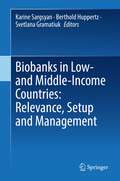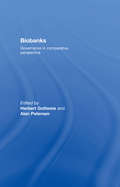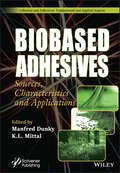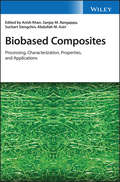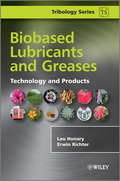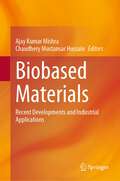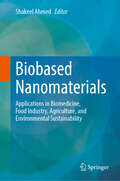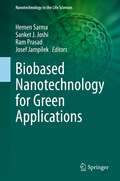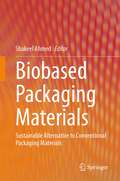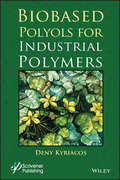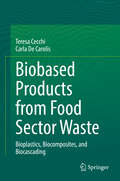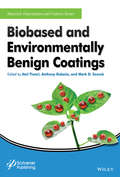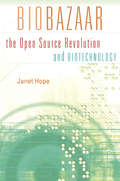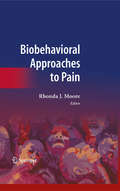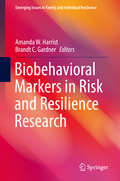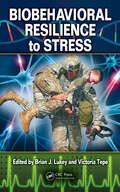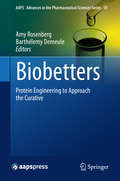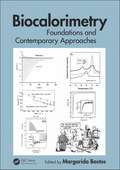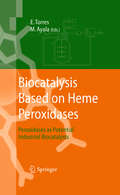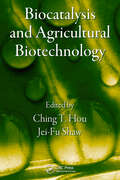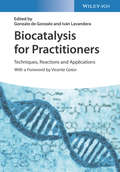- Table View
- List View
Biobanks in Low- and Middle-Income Countries: Relevance, Setup and Management
by Berthold Huppertz Karine Sargsyan Svetlana GramatiukThis book introduces the fundamentals of biobanking and guides through the practical planning thereof, with a special focus on the situation in low- and middle-income countries. On the example of the setup of a Ukrainian biobank the book discusses the main steps and aspects of successful biorepository implementation and management. Topics covered include collection, storage and shipping of samples, establishment of an IT system, development of a sustainability plan, and project and risk management. Furthermore, the importance of the formation of international biobanking societies such as the Ukraine Association of Biobanks is highlighted, and their main objectives and tasks are discussed.The book addresses life science and business professionals as well as national authorities who are interested in biobanking in general and in setting up a biobank in particular.
Biobanks: Governance in Comparative Perspective
by Alan Petersen Herbert GottweisIn recent years, a number of large population-based biobanks - genetic databases that combine genetic information derived from blood samples with personal data about environment, medical history, lifestyle or genealogy - have been set up in order to study the interface between disease, and genetic and environmental factors. Unsurprisingly, these studies have sparked a good deal of controversy and the ethical and social implications have been widely debated. Biobanks: Governance in Comparative Perspective is the first book to explore the political and governance implications of biobanks in Europe, the United States, Asia, and Australia. This book explores: the interrelated conditions needed for a biobank to be created and to exist the rise of the new bio-economy the redefinition of citizenship accompanying national biobank developments This groundbreaking book makes clear that biobanks are a phenomenon that cannot be disconnected from considerations of power, politics, and the reshaping of current practices in governance. It will be a valuable read for scholars and students of genetics, bioethics, risk, public health and the sociology of health and illness.
Biobased Adhesives: Sources, Characteristics, and Applications (Adhesion and Adhesives: Fundamental and Applied Aspects)
by K. L. Mittal Manfred DunkyBiobased Adhesives Unique and comprehensive book edited by acknowledged leaders on biobased adhesives that will replace petroleum-based adhesives. This book contains 23 chapters covering the various ramifications of biobased adhesives. The chapters are written by world-class scientists and technologists actively involved in the arena of biobased adhesives. The book is divided into three parts: Part 1: Fundamental Aspects; Part 2: Classes of Biobased Adhesives; and Part 3: Applications of Biobased Adhesives. Topics covered include: an introduction to biobased adhesives; adhesion theories and adhesion and surface issues with biobased adhesives; chemistry of adhesives; biorefinery products as biobased raw materials for adhesives; naturally aldehyde-based thermosetting resins; natural crosslinkers; curing and adhesive bond strength development in biobased adhesives; mimicking nature; bio-inspired adhesives; protein adhesives; carbohydrates as adhesives; natural polymer-based adhesives; epoxy adhesives from natural materials; biobased polyurethane adhesives; nanocellulose-modified adhesives; debondable, recyclable, and biodegradable biobased adhesives; 5-Hydroxymethylfurfural-based adhesives; adhesive precursors from tree-derived naval stores; and applications in various diverse arenas such as wood bonding, controlled drug delivery, and wearable bioelectronics. Audience This book will interest materials scientists, adhesionists, polymer chemists, marine biologists, food and agriculture scientists, and environmentalists. R&D personnel in a slew of wide-ranging industries such as aviation, shipbuilding, railway, automotive, packaging, construction, wood bonding, and composites should find this book a repository of current and much-needed information.
Biobased Composites: Processing, Characterization, Properties, and Applications
by Abdullah M. Asiri Anish Khan Suchart Siengchin Sanjay M. RangappaExplore the world of biocomposites with this one-stop resource edited by four international leaders in the field Biobased Composites: Processing, Characterization, Properties, and Applications delivers a comprehensive treatment of all known characterization methods, properties, and industry applications of biobased composites materials. This unique, one-stop resource covers all major developments in the field from the last decade of research into this environmentally beneficial area. The internationally recognized editors have selected resources that represent advances in the mechanical, thermal, tribological, and water sorption properties of biobased composites, and cover new areas of research in physico-chemical analysis, flame retardancy, failure mechanisms, lifecycle assessment, and modeling of biobased composites. The low weight, low cost, excellent thermal recyclability, and biodegradability of biobased composites make them ideal candidates to replace engineered plastic products derived from fossil fuel. This book provides its readers with the knowledge they'll require to understand a new class of materials increasingly being used in the automotive and packaging industries, aerospace, the military, and construction. It also includes: An extended discussion of the environmental impact of biobased composites using a life cycle methodology A review of forecasts of natural fiber reinforced polymeric composites and its degradability concerns An analysis of the physical and mechanical properties of a biobased composite with sisal powder A comprehensive treatment of the mechanical, thermal, tribological, and dielectric properties of biobased composites A review of processing methods for the manufacture of biobased composites Perfect for materials scientists in private industry, government laboratories, or engaged in academic research, Biobased Composites will also earn a place in the libraries of industrial and manufacturing engineers who seek a better understanding of the beneficial industrial applications of biocomposites in industries ranging from automobiles to packaging.
Biobased Industrial Products: Priorities for Research and Commercialization
by National Research CouncilPetroleum-based industrial products have gradually replaced products derived from biological materials. However, biologically based products are making a comeback--because of a threefold increase in farm productivity and new technologies.Biobased Industrial Products envisions a biobased industrial future, where starch will be used to make biopolymers and vegetable oils will become a routine component in lubricants and detergents.Biobased Industrial Products overviews the U.S. land resources available for agricultural production, summarizes plant materials currently produced, and describes prospects for increasing varieties and yields.The committee discusses the concept of the biorefinery and outlines proven and potential thermal, mechanical, and chemical technologies for conversion of natural resources to industrial applications.The committee also illustrates the developmental dynamics of biobased products through existing examples, as well as products still on the drawing board, and it identifies priorities for research and development.
Biobased Lubricants and Greases
by Lou Honary Erwin RichterDue to the rise in petroleum prices as well as increasing environmental concerns, there is a need to develop biochemicals and bioproducts that offer realistic alternatives to their traditional counterparts; this book will address the lack of a centralized resource of information on lubricants and greases from renewable sources, and will be useful to a wide audience in industry and academia. It is based on 20 years of research and development at the UNI-NABL Center, and discusses the various types of vegetable oils available, comparing their characteristics, properties and benefits against those of typical petroleum oils as well as discussing common evaluation tests and giving examples and case studies of successful applications of biobased lubricants and greases. Whilst scientific and engineering research data is included, the book is written in an accessible manner and is illustrated throughout. Focuses on an industrial application of lubrication technology undergoing current explosive growth in the global market.Includes a detailed review of the material benefits of plant-based lubricants that include a better viscosity index and lubricity even at extreme temperatures, lower flammability due to higher flash points and lower pour points.Covers the basic chemistry of vegetable oils as well as their profiles for use in lubricants and greases and environmental benefits.Includes examples and case studies of where vegetable-based lubricants have been successfully employed in industry applications.
Biobased Materials: Recent Developments and Industrial Applications
by Ajay Kumar Mishra Chaudhery Mustansar HussainThis book discusses the extraction, purification, modification, and processing of biobased materials and their various industrial applications, across biomedical, pharmaceutical, construction, and other industries. It includes contributions from experts on hybrid biopolymers and bio-composites, bioactive and biodegradable materials, bio-inert polymers, natural polymers and composites, and metallic natural materials. Therefore, this encyclopedia is a useful reference for scientists, academicians, research scholars, and technologists. Major challenges of biobased materials are their efficient development, cost-effective, and green & environment friendly production/applications. This encyclopedia answers these challenges to professionals and scientists for proper utilization of biobased materials. It presents the recent practices of biobased materials technology in different scientific and engineering domains. It helps the bounded industrial outcomes to reach the general readership of different domains. This encyclopedia bridges the technological gaps between the industrial and academic professionals and the novice young students/scholars. The interdisciplinarity of this encyclopedia makes it unique for a wide readership. The topic of biobased materials is currently popular in the scientific community, working in such following areas as Recycled materials, Renewable materials, Materials for efficiency, Materials for waste treatment, Materials for reduction of environmental load, Materials for easy disposal or recycle, Hazardous free materials, Materials for reducing human health impact, Materials for energy efficiency, Materials for green energy, etc. This is a relatively hot topic in materials science and has strong demands for energy, material and money savings, as well as heavy contamination problems, despite that the area of biobased materials belongs to most important fields of modern science & technology, no important encyclopedias have been published in the area of “biobased materials”
Biobased Nanomaterials: Applications in Biomedicine, Food Industry, Agriculture, and Environmental Sustainability
by Shakeel AhmedThis book comprehensively covers various aspects of biobased nanomaterials, including their types, fabrication methods, characterization techniques, and applications in different fields. The book starts with an introduction to biobased nanomaterials, highlighting their significance in various fields due to their unique properties. The first few chapters cover the different types of biobased nanomaterials, their properties, and how they are extracted from various natural sources. The methods of fabrication of biobased nanomaterials are discussed in detail, including the techniques for controlling their size, shape, and composition. It then delves into the characterization of biobased nanomaterials, discussing the different techniques used to determine their properties, including their morphology, size, structure, and composition. The subsequent chapters explore the various applications of biobased nanomaterials in different fields such as environmental applications, wound healing, tissue engineering, food industry, agriculture, sensing technology, biomedical applications, and energy storage devices. The advantages of biobased nanomaterials over traditional nanomaterials are highlighted, including their biodegradability and sustainability. The environmental concerns associated with biobased nanomaterials, as well as the health and safety concerns, are also discussed. The book concludes by looking at the prospects of biobased nanomaterials and how they can contribute to sustainable development. Overall, the book is an informative and comprehensive book that provides a thorough understanding of biobased nanomaterials and their various applications. It is a valuable resource for researchers, students, and professionals in various fields such as materials science, chemistry, biology, and environmental science. alike.
Biobased Nanotechnology for Green Applications (Nanotechnology in the Life Sciences)
by Ram Prasad Hemen Sarma Sanket J. Joshi Josef JampilekInvestigation on biobased nanomaterials has provided new insights into the rapidly advancing fields of the biomedical and environmental sciences by showing how these nanomaterials are effective in biomedicine and environmental remediation. These particles hold tremendous prospective applications, and are likely to become the next generation of particles in these areas. As such, research is ongoing and the data generated should have the potential for a sustainable future in both the environmental and biomedical fields.This book presents important findings on the role of and identification of novel applications of biobased nanomaterials. Unlike other books in this field, this book focuses entirely on sustainable application and remediation in biomedicine and environmental science. The chapters are written in such a way as to make them accessible to the reader, and furthermore, the volume can be readily adopted as a reference, or used as a guide for further research.This project was based on recent research (the last 5 years) and developed through an extensive literature search. The editors have also compiled some advanced, outstanding texts that should be of benefit to graduate students in their research.
Biobased Packaging Materials: Sustainable Alternative to Conventional Packaging Materials
by Shakeel AhmedThis book provides a comprehensive and authoritative review of recent developments in bio-based packaging materials along with an array of their industrial applications. It offers an interdisciplinary approach, combining food engineering, polymer science, materials science, and sustainable aspects of bio-based materials with their synthesis, properties, characterization, and applications in packaging materials. The book encloses chapters covering fundamental concepts, manufacturing, properties, characterization, and interaction of bio-based materials. It also discusses topics related to the different usage of bio-based materials, their environmental impact, regulations, safety aspects, circular economy, challenges, and opportunities allied to bio-based materials. It is an essential resource for academicians, researchers, students, and professionals interested in exploring the potential bio-based materials in food packaging.
Biobased Polyols for Industrial Polymers
by Deny KyriacosThe replacement of polyols synthesized from petrochemical by polyols originating from natural products, notably from vegetable oils and animal fats, has been the subject of research projects for a number of decades. Very recently, however, the polymers industry has intensified its efforts to include the “green products”, such as biobased polyols, in applications already available in the market. Examples of such applications include polyurethane foams, elastomers and epoxides. This book describes the extraction of the natural constituents of several fruits and plants as well as their chemical conversion to polyols. In addition to the chemistry involved in the process, particular emphasis is attributed to their applications.
Biobased Products from Food Sector Waste: Bioplastics, Biocomposites, and Biocascading
by Teresa Cecchi Carla De CarolisAn increased demand for waste upcycling has prompted the food industry to become more efficient in its handling of waste. Efficient utilization of food waste is of concern to consumers, environmentalists, and policy makers. In the past, food waste has been used for the production of bio-gas and bio-fuels, fertilizers and animal feed. Biobased products from food sector waste: Bioplastics, biocomposites, and biocascading proposes an innovative use of food waste—as filler in a bioplastic matrix.The upcycling of food industry waste to produce new composites has a number of beneficial features, including (i) avoiding the cost of waste disposal; (ii) reducing bio-based composites price; (iii) avoiding using edible resources as a starting material for bio-based composites (to eliminate competition between biomass use for food, feed, and material use); (iv) producing a non-food bio-based output different from existing outputs (bio-fuels or bio-energy). The production of value-added items supports the development of a circular and sustainable economy in a thriving bio-based sector via the emergence of food value chains.The authors explore the safety of bio-based products. Using an evidence-based approach, they detail the volatile profile of biobased products and underline the absence of priority air pollutants released by fossil plastics, which pose a significant public health threat. The volume also delves into socioeconomic considerations and environmental concerns related to the upcycling of food by-products. Finally, the authors address how advances in digital technology can make food waste upcycling a negative-cost process.
Biobased and Environmentally Benign Coatings
by Atul Tiwari Mark D. Soucek Anthony GalanisThis book will have the recent information on the developments in the emerging field of environmental-friendly coatings. Crucial aspects associtaed with coating research will be presented in form of the indivudual chapters. Close attention will be paid to include essential aspects that are necessary to understand the porperties and applications of the novel materials. Different methods and techniques of synthesis and charcaterization will be detailed as individual chapters. It will also discuss the characterization techniques used in the area of such coatings. there will be chapters that descirbe the current status and future prospects. The topics will be selected so they are easy to understand and useful to new scholars as well as advanced learners. No book has been written on this subject so far.
Biobazaar: The Open Source Revolution and Biotechnology
by Janet HopeFighting disease, combating hunger, preserving the balance of life on Earth: the future of biotechnological innovation may well be the future of our planet itself. And yet the vexed state of intellectual property law—a proliferation of ever more complex rights governing research and development—is complicating this future. At a similar point in the development of information technology, “open source” software revolutionized the field, simultaneously encouraging innovation and transforming markets. The question that Janet Hope explores in Biobazaar is: can the open source approach do for biotechnology what it has done for information technology? Her book is the first sustained and systematic inquiry into the application of open source principles to the life sciences. The appeal of the open source approach—famously likened to a “bazaar,” in contrast to the more traditional “cathedral” style of technology development—lies in its safeguarding of community access to proprietary tools without discouraging valuable commercial participation. Traversing disciplinary boundaries, Hope presents a careful analysis of intellectual property-related challenges confronting the biotechnology industry and then paints a detailed picture of “open source biotechnology” as a possible solution. With insights drawn from interviews with Nobel Prize–winning scientists and leaders of the free and open source software movement—as well as company executives, international policymakers, licensing experts, and industry analysts—her book suggests that open source biotechnology is both desirable and broadly feasible—and, in many ways, merely awaiting its moment.
Biobehavioral Approaches to Pain
by Rhonda J. Moore J. A. PaicePain is a common symptom, yet it is frequently underevaluated and undertreated. It is difficult to define, describe--and sometimes to prove. It's pain, and suspicions of exaggerations often add further insult to a patients' injuries. Biobehavioral Approaches to Pain translates this highly subjective experience--and its physical, psychological, social, and cultural dimensions--into practical insights key to transforming the field of pain management. This pathbreaking volume synthesizes a rich knowledge base from across disciplines, including neurobiologic, genetic, biobehavioral, clinical, narrative, substance abuse, health services,ethical and policy perspectives, for a deeper understanding of the impact of pain on individual lives and the larger society. Its international panel of contributors highlights special issues and review best practice guidelines, from placebo effects to cancer, Whiplash Associated Disorders to pain imaging to complementary medicine, phantom limb pain to gene therapies to AIDS. Among the topics covered: The distinction between acute and chronic pain: is it clinically useful? Improving clinical assessment of patients with pain. Age and sex differences in pain. The what, how and why of the placebo and nocebo effect Psychosocial and partner-assisted biopsychosocial interventions for disease-related pain Substance abuse issues in pain treatment. The personal, social and economic costs of chronic pain. Biobehavioral Approaches to Pain offers clinical and health professionals, psychologists, as well as specialists in pain management or palliative care, new directions in their ongoing dialogue with patients. Given the prevalence of pain in the general population, it should also interest researchers and students in the field of public health.
Biobehavioral Markers in Risk and Resilience Research (Emerging Issues in Family and Individual Resilience)
by Amanda W. Harrist Brandt C. GardnerThis comprehensive reference explores the current and future state of biobehavioral markers in family resilience research, with special focus on linking biological and physiological measures to behavioral and health outcomes. It brings together the latest biobehavioral data on child-parent and couple relationships, adversity, and other key areas reflecting new technological advances in biobehavioral studies and translates these findings into implications for real-world practice and policy. The contributors’ insights on biomarkers apply to emerging topics of interest (e.g., molecular genetics) as well as familiar ones (e.g., stress). Their interdisciplinary perspective helps to elaborate on risk and resilience factors for those creating the next generation of evidence-based interventions. Among the topics covered: <P><P> The immune system as a sensor and regulator of stress: implications in human development and disease <br>The psychobiology of family dynamics: bidirectional relationships with adrenocortical attunement <br>Intergenerational transmission of poverty: how low socioeconomic status impacts the neurobiology of two generations <br>The influence of teacher-child relationships on preschool children’s cortisol levels <br>Challenges and strategies for integrating molecular genetics into behavioral science <P><P>Besides its worth to researchers and practitioners studying and working with families at risk, Biobehavioral Markers in Risk and Resilience Research also has utility as a training text, offering a highly accessible presentation and discussion questions suited to classroom use.
Biobehavioral Resilience to Stress
by Victoria Tepe Brian J. LukeyMilitary service involves exposure to multiple sources of chronic, acute, and potentially traumatic stress, especially during deployment and combat. Notoriously variable, the effects of stress can be subtle to severe, immediate or delayed, impairing individual and group readiness, operational performance, and ultimately‘survival. A comprehensive co
Biobetters: Protein Engineering to Approach the Curative (AAPS Advances in the Pharmaceutical Sciences Series #19)
by Amy Rosenberg Barthélemy Demeule"Biobetters: Protein Engineering to Approach the Curative" discusses the optimization of protein therapeutic products for treatment of human diseases. It is based on the fact that though numerous important therapeutic protein products have been developed for life threatening and chronic diseases that possess acceptable safety and efficacy profiles, these products have generally not been reexamined and modified for an improved clinical performance, with enhancements both to safety and efficacy profiles. Advances in protein engineering, coupled with greatly enhanced understanding of critical product quality attributes for efficacy and safety, make it possible to optimize predecessor products for clinical performance, thereby enhancing patient quality of life and with the potential for great savings in health care costs. Yet despite such knowledge, there is little movement towards such modifications. This book examines engineering protein therapeutic products such that they exhibit an optimal, not just an adequate, clinical performance profile. Two product classes, therapeutic enzymes for lysosomal storage diseases (enzyme replacement therapies, ERT) and monoclonal antibodies (mAbs), are used as examples of what modifications to such proteins could be made to enhance clinical performance, "closer to a cure" as it were. For ERT, the key to optimizing clinical performance is to ensure the ERT is endowed with moieties that target the protein to the relevant target tissue. Thus, for Gaucher Disease, our best example of how to optimize an ERT to address a disease that manifests in specific target tissues (macrophages and monocytes), the enzyme has been extensively modified to target macrophages. For diseases such as Pompe Disease, largely a disorder of muscle, optimal performance of ERT will depend on endowing the enzyme with the ability to be taken up via the Mannose 6 Phosphate Receptor, and so one of the chapters in the book will discuss such approaches. Moreover, a major failure of biotechnology based products is to gain access to the CNS, a key target tissue in numerous diseases. Thus, a chapter has been devoted to strategies to access the CNS. Additionally, immune responses to therapeutic proteins can be highly problematic, eliminating the efficacy of life saving or highly effective protein therapeutics. This is especially poignant in the case of Pompe Disease wherein great improvement in muscle strength and functionality is lost following development of an immune response to the ERT with consequent patient deterioration and death. Thus, a chapter regarding protein engineering, as well as other non-clinical approaches to diminishing immunogenicity is a valuable part of the book. Monoclonal antibodies (mAbs) can be engineered to bind targets relevant to a wide variety of diseases; binding affinity, however, is only part of the equation and one of the chapters will present a molecular assessment approach that balances affinity with pharmacokinetics and manufacturability. As with other proteins immunogenicity can be problematic, being responsible for loss of efficacy of anti-TNF mAbs, often after prolonged successful treatment. The authors will also share their perspective on the consequences of physico-chemical modifications occurring to mAbs once they reach the circulation or their target, a research area open to further development from a protein engineering as well as analytical perspective. This book will also discuss novel platforms for protein therapeutics, technologies that exceed mAbs with respect to potency, and hence, potentially efficacy. These platforms consist largely of repeat domain proteins with very high affinity for their target ligands, but while potentially more efficacious, immunogenicity may be a major problem limiting use. The economics surrounding the issue of biobetters is another high-profile issue - this final chapter will explore the incentives and disincentives for developing biobetters and consider incentives that might make their pursuit more rewarding.
Biobot Analytics
by Mitchell B. Weiss Joshua Lev Krieger Raymond KluenderIn 2017, Newsha Ghaeli and Mariana Matus were deciding whether to leave their labs at the Massachusetts Institute of Technology, put other job opportunities aside, and dive full-time into founding a wastewater analysis start-up, Biobot. Ghaeli, an architect, and Matus, a computational biologist, had been turning sewage into information about "population health" and now had dreams of turning the data encoded in urine and stool into a viable and impactful business. In plainer terms, they planned to "tap into what you flush down the toilet every day." They'd been told not to. They'd been told their idea was too broad and their skills too narrow. They'd been told they had no defensible intellectual property and limited scalability. They'd been advised to choose other startups instead, and knew, as immigrants on temporary visas, if they failed at this venture, they might even have to leave the country. Despite the many hurdles and objections, Ghaeli and Matus felt mostly at ease about moving ahead. Were they missing something? Or was everyone else?
Biocalorimetry: Foundations and Contemporary Approaches
by Margarida BastosConnecting past, present, and future instrument development and use, Biocalorimetry: Foundations and Contemporary Approaches explores biocalorimetry's history, fundamentals, methodologies, and applications. Some of the most prominent calorimeter developers and users share invaluable personal accounts of discovery, discussing innovative techniques a
Biocapital: The Constitution of Postgenomic Life
by Kaushik Sunder RajanBiocapital is a major theoretical contribution to science studies and political economy. Grounding his analysis in a multi-sited ethnography of genomic research and drug development marketplaces in the United States and India, Kaushik Sunder Rajan argues that contemporary biotechnologies such as genomics can only be understood in relation to the economic markets within which they emerge. Sunder Rajan conducted fieldwork in biotechnology labs and in small start-up companies in the United States (mostly in the San Francisco Bay area) and India (mainly in New Delhi, Hyderabad, and Bombay) over a five-year period spanning 1999 to 2004. He draws on his research with scientists, entrepreneurs, venture capitalists, and policymakers to compare drug development in the two countries, examining the practices and goals of research, the financing mechanisms, the relevant government regulations, and the hype and marketing surrounding promising new technologies. In the process, he illuminates the global flow of ideas, information, capital, and people connected to biotech initiatives. Sunder Rajan's ethnography informs his theoretically sophisticated inquiry into how the contemporary world is shaped by the marriage of biotechnology and market forces, by what he calls technoscientific capitalism. Bringing Marxian theories of value into conversation with Foucaultian notions of biopolitics, he traces how the life sciences came to be significant producers of both economic and epistemic value in the late twentieth century and early twenty-first.
Biocatalysis Based on Heme Peroxidases: Peroxidases as Potential Industrial Biocatalysts
by Eduardo Torres Marcela AyalaThis monograph describes many applications of peroxidase-based biocatalysis in the biotechnology industry. The need for such a book emerges from the considerable amount of new data regarding the phylogeny, reaction mechanisms, thermodynamic characterization and structural features of fungal and plant heme peroxidases that has been generated in the past 10 years, since the last specialized book on peroxidases was published. The aim of this book is to present recent advances on such basic aspects as evolution, structure-function relation and catalytic mechanism as well as applied aspects, such as bioreactor and protein engineering, to provide the tools for rational design of enhanced biocatalysts and biocatalytic processes.
Biocatalysis and Agricultural Biotechnology
by Ching T. Hou Jei-Fu ShawWorldwide energy and food crises are spotlighting the importance of bio-based products - an area many are calling on for solutions to these shortages. Biocatalysis and Agricultural Biotechnology encapsulates the cutting-edge advances in the field with contributions from more than 50 international experts comprising sectors of academia, industry, an
Biocatalysis and Biomolecular Engineering
by Ching T. Hou Jei-Fu ShawAn expert overview of new technologies guiding the construction of a sustainable society This compendium of important insights from sixty distinguished international scholars looks at the significant advances in progressive environmental technology—especially the molecular engineering used on plants, animals, and microorganisms—as the game changer in the high-stakes race to reverse earth-damaging practices. Biocatalysis and Biomolecular Engineering covers subject matter on the latest developments in eco-friendly and energy-saving manufacturing processes with the emphasis on agricultural technology and bio-based products. Focusing its study on remedies that show promise in curing food and energy ills, this book examines groundbreaking work in various fields, such as nutraceuticals, genetic engineering of agricultural products, and bioenergy. Biocatalysis and Biomolecular Engineering: Can be used as a reference by teachers, graduate students, and industrial scientists who conduct research in bioscience and biotechnology Serves as the first book to bring together fundamentals and leading-edge technologies for the development of bio-based industrial products through biocatalysis; for example, it discusses the preparation of biofunctional micro- and nanoparticles Contains chapters by international experts from academia, industry, and government research institutes Biocatalysis and Biomolecular Engineering builds a cohesive, well thought out case for nurturing new discoveries in eco-technology by inviting critical discussion on devising viable solutions to sustaining the future wellness of humankind.
Biocatalysis for Practitioners: Techniques, Reactions and Applications
by Gonzalo De Gonzalo Iván LavanderaThis reference book originates from the interdisciplinary research cooperation between academia and industry. In three distinct parts, latest results from basic research on stable enzymes are explained and brought into context with possible industrial applications. Downstream processing technology as well as biocatalytic and biotechnological production processes from global players display the enormous potential of biocatalysts. Application of "extreme" reaction conditions (i.e. unconventional, such as high temperature, pressure, and pH value) - biocatalysts are normally used within a well defined process window - leads to novel synthetic effects. Both novel enzyme systems and the synthetic routes in which they can be applied are made accessible to the reader. In addition, the complementary innovative process technology under unconventional conditions is highlighted by latest examples from biotech industry.
